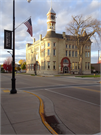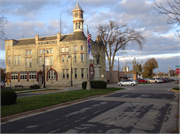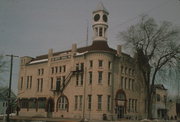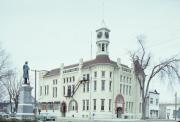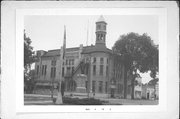Property Record
105 N DICKASON BLVD
Architecture and History Inventory
| Historic Name: | Columbus City Hall |
|---|---|
| Other Name: | CITY HALL |
| Contributing: | |
| Reference Number: | 3460 |
| Location (Address): | 105 N DICKASON BLVD |
|---|---|
| County: | Columbia |
| City: | Columbus |
| Township/Village: | |
| Unincorporated Community: | |
| Town: | |
| Range: | |
| Direction: | |
| Section: | |
| Quarter Section: | |
| Quarter/Quarter Section: |
| Year Built: | 1892 |
|---|---|
| Additions: | |
| Survey Date: | 1974 |
| Historic Use: | city hall |
| Architectural Style: | Romanesque Revival |
| Structural System: | |
| Wall Material: | Brick |
| Architect: | T.D. ALLEN |
| Other Buildings On Site: | |
| Demolished?: | No |
| Demolished Date: |
| National/State Register Listing Name: | Columbus City Hall |
|---|---|
| National Register Listing Date: | 9/4/1979 |
| State Register Listing Date: | 1/1/1989 |
| National Register Multiple Property Name: |
| Additional Information: | A 'site file' exists for this property. It contains additional information such as correspondence, newspaper clippings, or historical information. It is a public record and may be viewed in person at the State Historical Society, Division of Historic Preservation. ROUND CNR TOWER W/CLOCK AND BELL CUPOLA, ROUND ARCHES ON 1ST STORY. CORBELLED CORNICE. SQUARE CNR TOWER W/ROUND ARCH WINDOWS. MASSIVE ROUND ARCH WINDOW AND ENTRANCE. FIRE BELL AND TOWER WERE REMOVED IN 1948 WHEN THE FIRE DEPARTMENT MOVED TO A NEW LOCATION. LOCAL ARTIST SUSAN STARE HAS PAINTED MURALS ON THE INTERIOR OF THE CITY HALL. THERE IS AN AUDITORIUM ON THE SECOND FLOOR. The auditorium, originally designed by Truman D. Allen of Minneapolis, occupies the second and third floors of the Columbus City Hall. It was originally designed in 1891 to accommodate an audience of 600. The construction was completed in November 1892. In 2009, 487 of the original seats remain in very good condition. The auditorium was last occupied in the late 1940s and for reasons unclear, the second floor was closed to the public in the 1950s. "City offices and the police department are still housed inn this stately building. It was designed by T. D. Allen of Minneapolis using a masonry sampler of area materials; Watertown cream brick, Doylestown red sandstone and rock-faced Waukesha limestone. The fire bell and tower were removed from the west corner of the building when the fire department moved to a new location in 1948. On the interior, local artist Susan Stare has painted murals depicting early scenes of Columbus which line the walls of the hall. A wide, oak staircase ascends to a second floor auditorium. The auditorium was used for silent movies, traveling speakers, entertainers and school functions. The auditorium fell into a state of neglect. There is an increasing amount of local interest in restoring the auditorium." Columbus Historic Architecture Tours, undated. |
|---|---|
| Bibliographic References: | COLUMBUS HISTORIC ARCHITECTURE TOUR, COLUMBUS HISTORIC LANDMARKS AND PRESERVATION COMMISSION, 1994. MADISON CAPITAL TIMES 4/22/1996. Take a Walk on Main Street: Historic Walking Tours in Wisconsin's Main Street Communities, Wisconsin Main Street Program, 1998. Columbus History and Architecture Tours, 2009. Columbus Historic Architecture Tours, undated. |
| Wisconsin Architecture and History Inventory, State Historic Preservation Office, Wisconsin Historical Society, Madison, Wisconsin |

